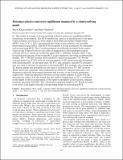Rotating radiative-convective equilibrium simulated by a cloud-resolving model
Author(s)
Khairoutdinov, Marat; Emanuel, Kerry Andrew
DownloadEmanuel_Rotating radiative.pdf (730.5Kb)
PUBLISHER_POLICY
Publisher Policy
Article is made available in accordance with the publisher's policy and may be subject to US copyright law. Please refer to the publisher's site for terms of use.
Terms of use
Metadata
Show full item recordAbstract
The results of a series of cloud-resolving radiative-convective equilibrium (RCE) simulations are presented. The RCE simulations, used as an idealization for the mean tropical climate, are run for a wide range of prescribed sea-surface temperatures (SSTs), from 21[superscript o]C to 36[superscript o]C, representing the range of past, present, and, possibly, future mean tropical SSTs. The RCE with constant Coriolis parameter f is contrasted with nonrotating RCE. The Coriolis parameter is artificially increased from typical values in the Tropics by about one order of magnitude to allow multiple tropical cyclones (TCs) to coexist in a relatively small 2300 × 2300 km[superscript 2] domain with a 3 km horizontal grid spacing. Nonrotating RCE is also simulated, but using a substantially smaller, 384 × 384 km[superscript 2] domain. Rotating RCE, which we nickname “TC World,” contains from 8 to 26 TCs with the average number of TCs monotonically decreasing with increasing SST. At the same time, the TCs' size, intensity, and per-TC precipitation rate tend to increase in response to increasing SST. For example, the average per-TC kinetic energy and precipitation rate tend to double for every 6[superscript o]C SST increase. These results are consistent with scaling laws in which TC velocities and inner core diameters scale with the potential intensity and its ratio to the Coriolis parameter, respectively, while the separation between cyclone centers appears to scale with the deformation radius. It is also found that the outflow temperature of TC's, as defined as the height of the local maximum of the upper-troposphere cloud fraction, remains relatively invariant with SST. The cold-point tropopause height in TC World is found to be about 2 km higher than the corresponding height in nonrotating RCE.
Date issued
2013-12Department
Massachusetts Institute of Technology. Department of Earth, Atmospheric, and Planetary SciencesJournal
Journal of Advances in Modeling Earth Systems
Publisher
American Geophysical Union (AGU)
Citation
Khairoutdinov, Marat, and Kerry Emanuel. “Rotating Radiative-Convective Equilibrium Simulated by a Cloud-Resolving Model.” Journal of Advances in Modeling Earth Systems 5, no. 4 (December 2013): 816–825. © 2013 American Geophysical Union
Version: Final published version
ISSN
19422466